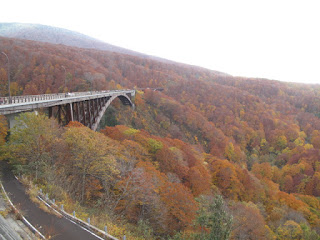A view from Jyougakura (城ヶ倉)
Since the Tohoku Shinkansen, the new bullet train line connecting Tokyo with Aomori 674 km (419 miles) distant opened in 2010, Tohok, the northern part of Japanese main island has become so easy to access for those living in the big metropolitan cities of Tokyo and its neghborhood. We got on the bullet train Hayabusa N o.3 at 7:42 am at JR Ueno station and reached to Hachinohe station at 10:31am, where our youngest son also joined us. He departed Tokyo last mid night on a long distance coach which is much cheaper than the bullet train although he is a very rich bachelor working in one of the top camera makers in Japan. On the way, the Hayabusa stopped at Morioka station for about 6 minutes in order to disconnect another bullet train Komachi going for Akita. Vice versa, when Hayabusa goes back to Tokyo from Aomori, it connects Komachi coming from Akita at this station. Every Japanese kids love to see this train connecting & disconnecting. My elder son quickly carried our grandson on his back to the front carriage of Hayabusa to let him see this actually happening while the train was stopping at Morioka. We were happy to see him so excited.
Komachi disconnected from Hayabusa at Morioka

From Hachinohe station we were heading for Lake Towada on a rent-a-car. This mysterious Lake is a caldera lake formed by the volcanic activities that began approximately 200,000 years ago, with the surface area of 61 km and the maximum depth of 327 meters. The lake is also well known for two decades efforts by Wainai Sadayuki to introduce princess trout (kokanee) into it, who had made it for the first time in 1903. Before that there was no fish in the lake. I was reminded of his great success which I learned in my elementary school days more than half a century ago. We got on the cruising boat at Yasumiya and enjoyed colorful Autumn leaves on the shore from the boat, which consist mainly of Erman’s birch and Siebold’s beech.
Lake Towada


After cruising, we drove up to Yachi Onsen, Yachi Hot Springs situated on the mountain's breast with the altitude of 782 meters above the sea level, where there was only one mountain Inn with hot spring that we were going to stay for two nights. It gives us a supreme happy feeling to take a bath in a hot spring and taste a dish prepared from edible wild plants and the lake's fish with Sake after a day's hiking. The mountain inn was quite and well harmonized with its surrounding natural environments.
Yachi Hot Springs (谷地温泉)

On the 2nd day, we went to Mt. Hakkoda for a small hiking with 3 year old grandson. Mt. Hakkoda actually refers to a mountain range with more than 10 peaks centered around the main highest peak of 1584 meters, Mt. Odake. We took a gondola of the aerial ropeway at the foot of Mt. Tamoyachidake which carried us to its summit station in about 10 minutes. It was severe cold with the temperature of minus 2 degrees and the trekking path muddy due to the melting snow of last night. So our eldest son was obliged to carry his son all the way on his back and we decided to take a short round trip of hiking trail. But the view was so magnificent that I realized Autumn deepening steadly in Mt. Hakkoda with leaves color changing from the peaks to the foots over the vast forests. Mt. Hakkoda is poised for winter coming.
Mt. Hakkoda (八甲田山)


As we ended up earlier with hiking around the summit station than our original plan, we looked for an alternative hiking trail which all of us would be able to enjoy hiking in a more comfortable way with the warmer temperature. So we decided to go to Tasirotai Marsh. This marsh is the largest in Mt. Hakkoda range and was originally the caldera lake formed by the volcanic activities of Mt. Hakkoda which ocurred 2 million years ago. The caldera has turned gradually into a marsh over long period of time. The marsh is abundant in beautiful wild flowers which are spectacular especially during June to August, and provides a good hiking trail which starts from the small turquoise blue pond. Hikers can walk easily on a path paved with planks over the marsh. Our grandson had never asked his dad to carry him on his back and was excited to try to find his favorite insects on the way. The marsh was quite, sunny, and giving us the pleasure of family hiking.
Tasirotai Marsh (田代平湿原)


On the final day of our trip, we visited Oirase stream on the way back to Hachinohe JR station. Probably Oirase is the most popular tourist destination in the Towada-Hakkoda region, so the place is very crowded especially on Saturday and Sunday with visitors coming from various countries including China, South Korea, and other Asean countries. That's why we came here on Monday 24th Oct. when we returned to Tokyo,
The Oirase stream runs through a mountain valley approximately 14 km long with its source in Lake Towada. With the clarity of the water, the incessantly changing flow over mossy rocks under forests of giant trees, and many waterfalls, those create the scenic beauty to its landscape. The path along the stream also parallels the car road on which public bus go periodically, so the visitors of any ages can start walking from anywhere in the course of 14 km distance in total and switch to getting on a bus if he or she feels tired in walking. We parked our rent-a-car at two points and enjoyed walking each for less than 45 minutes, so short time partly because it started to rain.
Oirase mountain stream (奥入瀬)









No comments:
Post a Comment